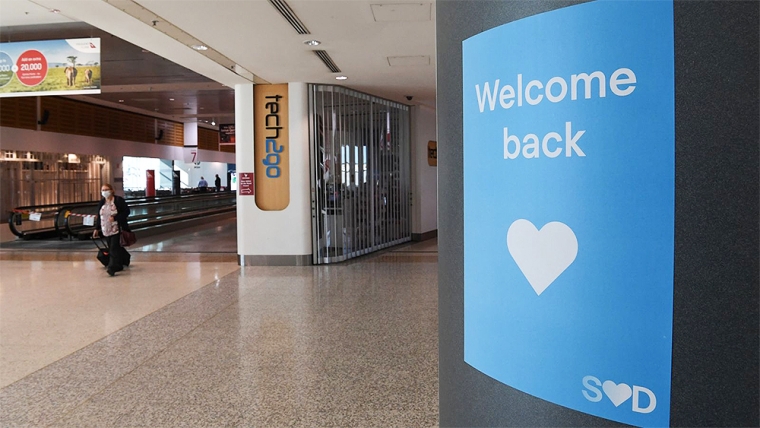
[Updated}
For most of the last two years, Australia’s international border has been essentially shut. It is currently open only to Australian citizens and permanent residents, foreign students, and working holiday visa holders.
But that is all about to change.
On Monday, the Prime Minister, Scott Morrison, announced that from 21 February “Australia will reopen to all fully vaccinated visa holders, welcoming the return of tourists, business travellers, and other visitors”. After two years of relative isolation, the country is reopening to the world.
Full reopening had not been expected until Easter. It is a surprise that it will come nearly two months earlier.
Of course, Australia being Australia, each state imposes its own separate restrictions on international arrivals. At the moment, most of the restrictions are reasonably minor. In New South Wales and Victoria, the primary requirement is to self-isolate and take a rapid antigen test in the first 24 hours. Provided the test is negative, you no longer need to isolate. The requirement in Queensland is similar.
There is one potential complication. The current definition of “fully vaccinated” is two doses. However, the Australian Technical Advisory Group on Immunisation (ATAGI) may extend that to three doses. Dan Andrews, the Premier of Victoria, wants to apply the three-dose test.
Western Australia, the eternal outlier, retains much tighter restrictions than the other states. Qantas CEO Alan Joyce has described the standout state as “starting to look like North Korea”. But of course, he would say that.
Western Australia aside, the Qantas chief cheered the reopening, saying that “Australia is finally back open for business”. Unsurprisingly, the Qantas share price rose strongly on the news, as did the prices of other Australian travel and tourist related stocks.
The headline of the Tourism and Transport Forum’s press release said it all – “Open sesame: Tourism industry jubilant at the return of international travellers”. CEO Margy Osmond said that the reopening provides “real hope for an industry that has borne the brunt of the impact of the Covid-19 pandemic”.
In the year to December 2019, Australia received 9.5 million international travellers who spent more than A$45 billion. The two-year disappearance of that industry, a major Australian export earner, has been one of the greatest economic costs of the pandemic.
TTF CEO Osmond recognises the real challenges to restarting Australia’s international tourism business after such an extended hiatus -
“There is still much to be done in attracting airlines back who unsurprisingly withdrew services during the pandemic enforced border closure, to entice tourists back from key international markets in what will be an increasingly competitive marketplace and importantly to address the skills shortages crippling the industry.”
Osmond identifies three key issues here. First, many airlines have been occupied elsewhere during the pandemic. It will take time for them to reallocate resources to the Australian market. That reallocation may be tempered by uncertainty as to how quickly consumers will return to old habits.
To what extent will ‘working from home’ and ‘zooming’ impact on future business travel to and from Australia? For business people in many countries, Australia is a time-consuming destination. Will Covid-19 anxiety limit the desire of tourists from Europe, America, and Asia to travel the relatively long distance to Australia? For many would-be tourists, Australia is a long way from home if something goes wrong.
The second key issue is the competitive nature of international tourism as the world emerges from the Covid-19 pandemic. Countries and businesses will be competing aggressively to attract foreign visitors. Many of them have a big head start on Australia. The land down under will not have been on the radar of many international tour operators in preparing trips and deals for 2022. There is a lot of catching up to do.
The third key issue identified by the TTF CEO is the current skills shortage in Australia. Two years of practically no immigration and few working backpackers has left many travel-related businesses, particularly hospitality, chronically short of staff. That will take time to turn around.
Perhaps the single biggest problem facing the Australian travel industry is the approach to Covid-19 in its two largest international markets – China and New Zealand. In 2019, Australia received more than 1.4 million visitors from each of those countries.
China currently places severe limitations on Chinese people travelling abroad so they will not be coming to Australia any time soon. New Zealand’s stringent self-isolation requirements for returning travellers effectively mean that it is not practical for most kiwis to travel to Australia for a short holiday or to visit family and friends.
Headwinds like these suggest that it may be several years before Australian tourism returns to pre-pandemic levels. In the meantime, state and federal governments are focusing on the restart of immigration and the return of foreign students and international working backpackers.
Australia is ‘short’ of the hundreds of thousands of immigrants that, absent Covid-19, would have settled here over theprevious two years. Last October, the NSW government proposed that the country should look to make up that shortfall by dramatically increasing immigrant numbers. One suggestion was to take up to two million people over the next five years. So far, the federal government has rejected any such ‘catch up’ approach.
There is a federal election due by May and accelerating immigration could be a potentially dangerous policy to take to the electorate. An explosion in the number of new immigrants might solve skills shortages for businesses but for some it would be seen as undermining wage growth and placing even more pressure on already stretched public services and infrastructure.
Last month, Prime Minister Morrison delivered a message to foreign students and international backpackers overseas who are holding visas to come to Australia. “Come on down” he urged them. As an inducement, the government is offering to rebate their $630 visa application.
Morrison wants the approximately 150,000 students and 25,000 backpackers with Australian visas to travel here for two reasons. To spend money and to fill chronic workforce shortages, particularly in the healthcare, agricultural, and hospitality sectors. Tourism Australia is launching a specific marketing campaign to lure these people to Australia.
There is a great deal at stake for Australia in all this. State and federal governments have spent hundreds of billions of dollars over the last couple of years combatting the dual health and economic crises triggered by Covid-19.
The return of international tourists, immigrants, foreign students, and working backpackers will be a vital contributor to the strong economic recovery Australia now needs to pay off the massive debts it has incurred and to ensure the country’s ongoing prosperity. And to prepare for the next major crisis.
Ross Stitt is a freelance writer and tax lawyer with a PhD in political science. He is a New Zealander based in Sydney. His articles are part of our 'Understanding Australia' series.

We welcome your comments below. If you are not already registered, please register to comment.
Remember we welcome robust, respectful and insightful debate. We don't welcome abusive or defamatory comments and will de-register those repeatedly making such comments. Our current comment policy is here.